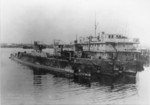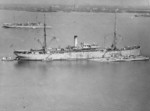S-27
| Country | United States |
| Ship Class | S-class Submarine |
| Hull Number | SS-132 |
| Laid Down | 11 Apr 1919 |
| Launched | 18 Oct 1922 |
| Commissioned | 22 Jan 1924 |
| Sunk | 19 Jun 1942 |
| Displacement | 868 tons standard; 1,079 tons submerged |
| Length | 219 feet |
| Beam | 21 feet |
| Draft | 16 feet |
| Machinery | Two New London Ship & Engine diesel engines, two Ridgeway Dynamo & Electric Co. electric motors, battery cells, two shafts |
| Bunkerage | 41,192gal diesel fuel |
| Speed | 14 knots |
| Crew | 42 |
| Armament | 1x4in/50cal deck gun, 4x21in torpedo tubes, 12 torpedoes |
| Submerged Speed | 11 knots |
Contributor: C. Peter Chen
ww2dbaseThe construction for submarine S-27 was authorized in Mar 1917, and her keel was laid down by the Bethlehem Shipbuilding Corporation's Fore River Shipyard in Quincy, Massachusetts, United States in Apr 1919. Launched in Oct 1922, she was commissioned into service at Groton, Connecticut, United States in Jan 1924. In 1925, she shifted from New London, Connecticut to San Diego, California, United States until 1931 when she was transferred to Pearl Harbor, US Territory of Hawaii. In May 1939, Lieutenant William Stovall, Jr. was named her commanding officer. In Jun 1939, she was transferred to San Diego where she served with the Underwater Sound Training School. In Nov 1941, she sailed to Mare Island Navy Yard in Vallejo, California for an extended period of overhaul. She was still at Mare Island when the United States became an belligerent in WW2 after the Dec 1941 raid on Pearl Harbor. After the overhaul was complete, she departed San Francisco Bay for San Diego, where she would resume serving with the Underwater Sound Training School. In May 1942, under a new commanding officer, Lieutenant Herbert Jukes, she was ordered to patrol waters off of the US Territory of Alaska. On 18 Jun 1942, she reconnoitered Constantine Harbor, Amchitka Island, US Territory of Alaska, planned site of the future Amchitka Airfield. Noting no activity at the evacuated village, she sailed east as she set a course toward the southern shore of the island. Due to the prolonged daylight hours in this region, she had been sailing under the surface, and her batteries were nearly depleted. At about 0000 hours on 19 Jun 1942, she surfaced to recharge. Heavy fog prevented the crew from realizing that she had drifted as much as 8 kilometers (five miles) from her original position when the battery charging operations began. At 0043 hours on 19 Jun 1942, her crew sighted a large wave about 23 meters (about 25 yards) forward of her bow. Orders were given to back up immediately, leading to her running onto rocks off St. Makarius Point. Large waves struck her while she was on the rocks, rolling her 10 to 15 degrees on each side. Attempts to back off the rocks failed even after the crew dumped fuel to lighten the submarine. At 0115 hours, she transmitted one of the six distress signals she would send out, but Dutch Harbor at Unalaska more than 1,000 kilometers (600 miles) away only received one of them, and that message did not include their exact location. By 0330 hours, the sea grew rougher, and Jukes ordered a number of crew members evacuated to the island via rubber boats. By 1100 hours, all were safely on the beach except for Jukes and five others, who destroyed key pieces of equipment and burned classified documents. At 1530 hours, plating at the torpedo room gave way to waves, and water rushed in. At 1550 hours, the submarine was fully abandoned. The crew spent the night of 19 to 20 Jun 1942 in an unsheltered cove, huddled around fires. After dawn on the following day, they made their way across to the northern side of the island and set up a camp on the shores of Constantine Harbor, using buildings of the evacuated village, with still-functioning heating equipment, for shelter. Crew members continued to hike back and forth from the original cove to the camp, carrying the equipment and provisions that they had initially saved from the submarine, and those that they had recovered after reboarding the submarine on 21 Jun and again on 22 Jun. On 24 Jun, A US Navy PBY Catalina flying boat piloted by Lieutenant (jg) Julius Raven chanced upon them, and took on 15. On the next day, three more flying boats arrived to take on the rest of the S-27 survivors.
ww2dbaseSources:
US Navy
Wikipedia
Last Major Revision: Feb 2023
Submarine S-27 (SS-132) Interactive Map
Photographs
 |  |
S-27 Operational Timeline
| 11 Apr 1919 | The keel of S-27 was laid down at the Bethlehem shipyard in Quincy, Massachusetts, United States. |
| 18 Oct 1922 | S-27 was launched at the Bethlehem shipyard in Quincy, Massachusetts, United States, sponsored by Alice Baldwin (née Blackwood), wife of retired US Army general Frank Baldwin. |
| 22 Jan 1924 | USS S-27 was commissioned into service at Groton, Connecticut, United States. |
| 23 Feb 1931 | USS S-27 arrived at Pearl Harbor, US Territory of Hawaii. |
| 16 Jun 1939 | USS S-27 departed Pearl Harbor, US Territory of Hawaii. |
| 27 Jun 1939 | USS S-27 arrived at San Diego, California, United States. |
| 23 Jan 1942 | USS S-27 departed San Francisco Bay, California, United States. |
| 26 Jan 1942 | USS S-27 arrived at San Diego, California, United States. |
| 20 May 1942 | USS S-27 departed San Diego, California, United States. |
| 12 Jun 1942 | USS S-27 departed Dutch Harbor, Unalaska, US Territory of Alaska. |
| 16 Jun 1942 | While at sea, after sundown, USS S-27 received orders to sail to Kiska, US Territory of Alaska. |
| 18 Jun 1942 | USS S-27 reconnoitered Constantine Harbor, Amchitka Island, US Territory of Alaska, planned site of the future Amchitka Airfield. |
| 19 Jun 1942 | USS S-27 ran aground south of Amchitka Island, US Territory of Alaska at about 0043 hours. Unable to free the submarine, commanding officer Herbert Jukes ordered the ship abandoned, and the entire crew made their way to the island by 1600 hours. |
| 20 Jun 1942 | The crew of USS S-27 established a camp in the abandoned buildings on the shores of Constantine Harbor, Amchitka Island, US Territory of Alaska. |
| 21 Jun 1942 | The crew of USS S-27 reboarded the submarine, which had run aground south of Amchitka in the US Territory of Alaska two days prior, and recovered supplies. |
| 22 Jun 1942 | The crew of USS S-27 reboarded the submarine, which had run aground south of Amchitka in the US Territory of Alaska two days prior, and recovered supplies. Due to the detection of chlorine gas, the crew would not make another attempt to board the wreck again. |
| 24 Jun 1942 | A US Navy PBY Catalina flying boat piloted by Lieutenant (jg) Julius Raven came across the survivors of USS S-27, which ran aground five days prior, on Amchitka Island, US Territory of Alaska by chance. The aircraft took off 15 survivors, and called for additional aircraft. |
| 25 Jun 1942 | Three flying boats arrived at Constantine Harbor, Amchitka Island, US Territory of Alaska to pick up the last of the survivors of USS S-27, which had run aground six days prior. |
Did you enjoy this article or find this article helpful? If so, please consider supporting us on Patreon. Even $1 per month will go a long way! Thank you. Share this article with your friends: Stay updated with WW2DB: |
- » Wreck of USS Edsall Found (14 Nov 2024)
- » Autumn 2024 Fundraiser (7 Nov 2024)
- » Nobel Peace Prize for the Atomic Bomb Survivors Organization (11 Oct 2024)
- » Wreck of USS Stewart/DD-224 Found (2 Oct 2024)
- » See all news
- » 1,150 biographies
- » 337 events
- » 43,917 timeline entries
- » 1,241 ships
- » 350 aircraft models
- » 207 vehicle models
- » 375 weapon models
- » 123 historical documents
- » 260 facilities
- » 470 book reviews
- » 28,548 photos
- » 432 maps
Lt. Gen. Lewis B. "Chesty" Puller, at Guadalcanal